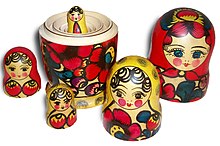A doll is a model of a human being, often used as a toy for children. Dolls have traditionally been used in magic and religious rituals throughout the world, and traditional dolls made of materials like clay and wood are found in the Americas, Asia, Africa and Europe. The earliest documented dolls go back to the ancient civilizations of Egypt, Greece and Rome. Dolls being used as toys was documented in Greece around 100AD. They have been made as crude, rudimentay playthings as well as elaborate art. Modern doll manufacturing has its roots in Germany going back to the 15th century. With industrialization and the appearance of new materials like porcelain and plastic, dolls were increasingly mass produced. During the 20th century dolls became increasingly popular as collectibles.
Contents[hide] |
[edit] History, types and materials
[edit] Early history and traditional dolls

Traditional dolls are sometimes used as children's playthings, but they may also have spiritual, magical and ritual value. There is no defined line between spiritual dolls and toys. In some cultures dolls that had been used in rituals were given to children. They were also used in childrens education and as carriers of cultural heritage. In other cultures dolls were considered too laden with magical powers to allow children to play with them.[4]
African dolls are used to teach, and entertain, they are supernatural intermediaries, and they are manipulated for ritual purposes. Their shape and costume vary according to region and custom. Frequently dolls are handed down from mother to daughter. Akuaba are wooden ritual fertility dolls from Ghana and nearby areas. The best known akuaba are those of the Ashanti people, whose akuaba have large, disc-like heads. Other tribes in the region have their own distinctive style of akuaba.
There is a rich history of Japanese traditional dolls dating back to the Dogū figures (8000-200 BC) and Haniwa funerary figures (300-600 AD). By the eleventh century dolls were used as playthings as well as for protection and in religious ceremonies. During Hinamatsuri, the doll festival, hina dolls are displayed. These are made of straw and wood, painted, and dressed in elaborate, many-layered textiles. Daruma dolls are spherical dolls with red bodies and white faces without pupils. They represent Bodhidharma, the East Indian who founded Zen, and are used as good luck charms. Wooden Kokeshi dolls have no arms or legs, but a large head and cylindrical body, representing little girls.
The use of an effigy to perform a spell on someone is documented in African, Native American, and European cultures. Examples of such magical devices include the European poppet and the nkisi or bocio of West and Central Africa. In European folk magic and witchcraft, poppet dolls are used to represent a person, for casting spells on that person. The intention is that whatever actions are performed upon the effigy will be transferred to the subject based in sympathetic magic. The practice of sticking pins in so called voodoo dolls have been associated with African-American Hoodoo folk magic. Voodoo dolls are not a feature of Haitian Vodou religion, but have been portrayed as such in popular culture, and stereotypical voodoo dolls are sold to tourists in Haiti. Likely the voodoo doll concept in popular culture is influenced by the European poppet dolls.[5] A kitchen witch is a poppet originating in Northern Europe. It resembles a stereotypical witch or crone and is displayed in residential kitchens as a means to provide good luck[6] and ward off bad spirits.[7]


In Germany clay dolls have been documented as far back as the 13th century, and wooded doll making from the 15th century.[14] Beginning about the 15th century, increasingly elaborate dolls were made for Nativity scene displays, chiefly in Italy.[15] Dolls with detailed, fashionable clothes were sold in France in the 16th century, though their bodies were often crudely constructed.[16] The German and Dutch peg wooden dolls were cheap and simply made, and were popular toys for poorer children in Europe going back to the 16th century.[17] Wood continued to be the dominant material for dolls in Europe until the 19th century.[18] Through the 18th and 19th centuries wood was increasingly combined with other materials, like leather, wax and porcelain and the bodies made more articulate.[18] It is unknown when dolls' glass eyes first appeared, but brown was the dominant eye color for dolls up until the Victorian era when blue eyes became more popular, inspired by Queen Victoria.[19]
[edit] Industrial era
During the 19th century dolls' heads were often made of porcelain and combined with a body of leather, cloth, wood, or composite materials, like papier-mâché or composition, a mix of pulp, sawdust, glue and similar materials.[20][21] With the advent of polymer and plastic materials in the 20th century, doll making largely shifted to these materials. The low cost, ease of manufacture and durability of plastic materials meant new types of dolls could be mass produced at a lower price. The earliest materials were rubber and celluloid. From the mid-20th century soft vinyl became the dominant material, in particular for childrens dolls.[22][23] Beginning in the 20th century, both porcelain and plastic dolls are made directly for the adult collectors market. Synthetic resins like polyurethane resemble porcelain in texture and are used for collectible dolls.
Up through the middle of the 19th century, European dolls were predminantly made to represent grown-ups. Child-like dolls and the later ubiquitous baby doll did not appear until around 1850.[26][29] But by the late century baby and child-like dolls had overtaken the market.[26] Realistic, lifelike wax dolls were popular in Victorian England.[30]
Paper dolls are cut out of paper, with separate clothes that are usually held onto the dolls by folding tabs. They often reflect contemporary styles, and 19th century ballerina paper dolls were among the earliest celebrity dolls. The 1930s Shirley Temple doll sold millions and were one of the most successful celebrity dolls. Small celluloid Kewpie dolls, based on illustrations by Rose O'Neill, were popular in the early 20th century. Madame Alexander created the first collectible doll based on a licensed character – Scarlett O'Hara from Gone with the Wind.[31]
Contemporary dollhouses have their roots in European baby house display cases from the 17th century. Early dollhouses were all handmade, but following the Industrial Revolution and World War II, they were increasingly mass produced and became more affordable. Children's dollhouses have during the 20th century been made of tin litho, plastic, and wood. Contemporary houses for adult collectors are typically made of wood.
The earliest modern stuffed toys were made in 1880. They differ from earlier rag dolls in that they are made of plush furlike fabric and commonly portray animals rather than humans.[32] Teddy bears first appeared in 1902-1903.[32][33]

Fashion dolls are primarily designed to be dressed to reflect fashion trends and are usually modeled after teen girls or adult women. The earliest fashion dolls were French bisque dolls from the mid-19th century. Contemporary fashion dolls are typically made of vinyl. Barbie from the American toy company Mattel dominated the market from her inception in 1959.[35] Bratz was the first doll to challenge Barbie's dominance, reaching forty percent of the market in 2006.[36]
Plastic action figures, often representing superheroes, are particularly popular among boys.[37] Fashion dolls and action figures are often part of a media franchise which may include films, TV, video games and other related merchandise. Bobblehead dolls are collectible plastic dolls with heads connected to the body by a spring or hook[38] in such a way that the head bobbles. They often portray baseball players or other athletes.

Also with the advent of the Internet, collectible dolls are customized and sold or displayed online. Reborn dolls are vinyl dolls that has been customized to resemble a human baby with as much realism as possible. They are often sold online through sites like eBay.[39][40] Asian ball-jointed dolls (BJDs) are cast in synthetic resin in a style that has been described as both realistic and influenced by anime.[41][42][43] Asian BJDs and Asian fashion dolls like Pullip and Blythe are often customized and photographed. The photos are shared in online communities.[44][45]
[edit] Uses, appearances and issues
Since ancient times, dolls have played a central role in magic and religious rituals, or used as representations of a deity. Dolls have also traditionally been toys for children. Dolls are also collected by adults, for their nostalgic value, beauty, historical importance or financial value.[46] Antique dolls which were originally made as children's playthings have become collector's items. Nineteenth-century bisque dolls made by French manufacturers such as Bru and Jumeau may be worth almost $22,000 today.[47]Dolls have traditionally been made as crude, rudimentay playthings as well as with elaborate, artful design.[48] They have been created as folk art in cultures around the globe, and in the 20th century, art dolls began to be seen as high art. Artist Hans Bellmer made surrealistic dolls that had interchangeable limbs in 1930s and 1940s Germany as opposition to the Nazi party's idolization of a perfect Aryan body.[46] East Village artist Greer Lankton became famous in the 1980s for her theatrical window displays of drug addicted, anorexic and mutant dolls.[49]
Lifelike or anatomically correct dolls are used by health professionals, medical schools and social workers to train doctors and nurses in various health procedures or investigate cases of sexual abuse of children. Artists sometimes use jointed wooden mannequins in drawing the human figure.
In Western society, a gender difference in the selection of toys has been observed and studied. Action figures that represent traditional masculine traits are popular with boys, who are more likely to choose toys that have some link to tools, transportation, garages, machines and military equipment. Dolls for girls tend to represent feminine traits and come with such accessories as clothing, kitchen appliances, utensils, furniture and jewelry.[50][51][52]
Pediophobia is a fear of dolls or similar objects.[53][54] Psychologist Ernst Jentsch theorized that uncanny feelings arise when there is an intellectual uncertainty about whether an object is alive or not. Sigmund Freud further developed on these theories.[55] Japanese roboticist Masahiro Mori expanded on these theories to develop the uncanny valley hypothesis. If an object is obviously enough non-human, its human characteristics will stand out, and be endearing. However, if that object reaches a certain threshold of human-like appearance, its non-human characteristics will stand out, and be disturbing.[56]





 16.49
16.49
 Doll
Doll











0 komentar:
Posting Komentar